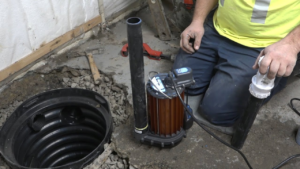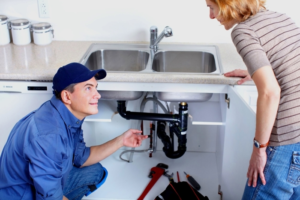A sump pump effectively prevents moisture buildup in a home’s basement or crawl space. Dampness can cause structural damage and rot, while pests love damp environments.
A sump pump works by draining water from the basin through a discharge pipe that runs to the house’s exterior. The pipe should slope away from the house to prevent backflow. Click the Sump Pump Installation Aurora CO to learn more.

If you’re installing a new sump pump or replacing an old one, there are several factors to consider. For example, a pump that is too powerful or not sized correctly can cause premature wear and reduce the efficiency of the system. This can lead to a short service life and increased energy costs.
The type of media (water, wastewater, chemicals) to be transported should also be taken into account when selecting a pump. The fluid viscosity, suction temperature and whether the media contains solid elements should be considered as well. This information will help determine if a positive displacement or centrifugal pump is better suited to the application.
It is important to evaluate the discharge line length as well. The discharge pipe will need to be able to transport the water from the sump up to ground level. If the discharge line is prone to problems such as blockages, clogs or other issues, it may need to be replaced with a longer, larger diameter line. A professional plumber will be able to advise on this matter.
Another factor to consider is local regulations on where the water can be discharged. Some towns have strict guidelines on where a sump pump can discharge into and this could impact the cost of the project. Alternative drainage systems can be installed to help mitigate these limitations such as underground discharge pipe extensions, rain gardens, dry well installations and retention/detention ponds.
A battery backup system can be added to the pump to provide additional protection in case of a power outage or other disruption. The cost of this will be a little more but the peace of mind is well worth it.
Pump maintenance requirements and spare parts availability should also be considered as this will affect overall operating costs. The best pumps are designed for easy and straightforward maintenance with readily available spare parts.
Finally, a sump pump should be rated for the ambient temperature of the environment and if a corrosive atmosphere is present, a pump constructed of materials that are resistant to corrosion should be selected.
Dig the Pit
When installing a sump pump, you need to dig a pit in your basement floor (or sometimes above-ground) for the watertight container that will hold the pump and the discharge pipe. You also need a power outlet close to the pit. In addition, you’ll want to install a battery back-up unit that will allow your sump pump to function for up to 24 hours without power.
Before starting any work, you should read the sump pump owner’s manual thoroughly to familiarize yourself with the pump and its features. It will explain all of the safety warnings and help you decide what type of sump pump is right for your home.
The first step in preparing for the installation is to mark the area where you plan to dig the sump pump pit. This will be the lowest point of your basement or crawl space, where water collects most frequently. Then, you’ll need to dig a hole that is at least 18 inches wide and 24 inches deep.
Once the pit is dug, you’ll need to line it with gravel. This will prevent the pump from sucking up dirt and debris that could damage it. Then, you’ll need to install the drainage pipe. This is typically a perforated pipe that connects to the sump pump. It should be sloped towards the pump to ensure that water flows into it.
If your house is built on a concrete slab, you may need to add a concrete pad at the bottom of the basement floor to support the pump and keep it stable. You should also make sure that the pit is located close to a ground fault circuit interrupter (GFCI) outlet, since working with electricity near water can be dangerous.
Once the pit is ready, you can seat the sump basin in it. It is often best to rest the basin on a paver stone to raise it up a little bit so that it doesn’t have to sit directly on the concrete floor. Then, you can fill the excavation with concrete, mixing it well and troweling it to achieve a smooth surface.
Install the Pump
Assuming you have a working sump pump, you can install it in the basin by following the manufacturer’s instructions. It is important to follow these steps precisely, as it will determine the pump’s function and whether or not it is effective at keeping your home dry.
Once the pump is in place, it should be plugged into a GFCI outlet to ensure safety and prevent electrocution. Alternatively, you may want to have an electrician set up a dedicated circuit to power the sump pump. This option is safer, as it will reduce the risk of a tripped circuit breaker or fuse. It also eliminates the need to use an extension cord, which could potentially damage your basement’s insulation.
Before placing the pump in the basin, make sure that it stands upright and level. It is also a good idea to install a check valve on the discharge pipe, which will keep water from flowing back into the pit once it has been pumped out. The discharge pipe should run to a drainage ditch or storm drain, and it should slope away from your home’s foundation.
You should also make sure that the float switch is unobstructed and can move freely up and down, as this will activate and deactivate the pump when necessary. To prevent clogging, you should periodically empty the pump and wash out the discharge line with water to remove dirt and debris that can block the pump’s flow.
It is also important to test the pump’s function by pouring water into the basin. If the pump works correctly, it should turn on when the water reaches the float switch and then continuously pump out the water until the float switch is lowered again. If the pump fails to turn on or runs continuously, it will likely be due to a faulty or stuck switch, so it should be replaced.
To prevent the discharge line from freezing in cold winter temperatures, you should consider installing a heat trace or other type of heating cable along its length. You should also be aware of the potential for a frozen ground fault circuit interrupter (GFCI) to trip, which can cause the pump to shut off and leave your basement inundated with water.
Test the Pump
Ensure the sump pump is working correctly by testing it before heavy rains or flooding occur. The best way to test the pump is to slowly pour water into it from a bucket or cooking pot. The pump should activate when the float rises enough to trigger the switch and start removing water from the basin. Once the water level drops, the pump should turn off automatically. If the pump does not operate correctly, contact a basement waterproofing specialist to diagnose the problem.
If the float switch on your sump pump is not functioning properly, it won’t activate when needed to drain your basement or crawl space. If your pump has a check valve, verify that it is properly installed and not clogged with dirt or debris. A check valve is installed on the discharge pipe to prevent water from flowing back into the sump basin after the pump shuts off.
A basement waterproofing contractor can help install a check valve and other components such as a vapor barrier, drain tiles, and a sump pit or basin. A professional can also determine the best size pump for a home, install it in the hole, and backfill around it with excavated soil. They may also recommend a drainage system that involves troughs filled with gravel and drain pipe if your foundation walls have cracks or a sump pump for homes in sandy, porous soil.
Before testing the pump, locate and trace the two electrical cords that go to the sump pump. There is likely one cord that plugs into the float switch and another that plugs into the pump motor. Unplug both cords and inspect the plug ends for signs of damage. Once they are free of debris, plug the float cord into an outlet first, followed by the pump cord. Check the float switch to make sure it is still plugged into the outlet and that the protective coating has not been removed or cracked. If the float switch is damaged, the pump will not function correctly and could lead to severe water damage in your basement or crawl space.
